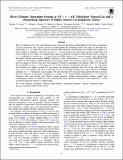| dc.contributor.author | Cooper, Thomas J | |
| dc.contributor.author | Simcoe, Robert A | |
| dc.contributor.author | Cooksey, Kathy L | |
| dc.contributor.author | Bordoloi, Rongmon | |
| dc.contributor.author | Miller, Daniel R | |
| dc.contributor.author | Furesz, Gabor | |
| dc.contributor.author | Turner, Monica L | |
| dc.contributor.author | Bañados, Eduardo | |
| dc.date.accessioned | 2021-09-20T18:22:01Z | |
| dc.date.available | 2021-09-20T18:22:01Z | |
| dc.date.issued | 2019 | |
| dc.identifier.uri | https://hdl.handle.net/1721.1/132357 | |
| dc.description.abstract | © 2019. The American Astronomical Society. All rights reserved.. Ratios of different ions of the same element encode ionization information independently from relative abundances in quasar absorption line systems, crucial for understanding the multiphase nature and origin of absorbing gas, particularly at z > 6 where H i cannot be observed. Observational considerations have limited such studies to a small number of sightlines, with most surveys at z > 6 focused upon the statistical properties of individual ions such as Mg ii or C iv. Here we compare high- and low-ionization absorption within 69 intervening systems at z > 5, including 16 systems at z > 6, from Magellan/FIRE spectra of 47 quasars together with a Keck/High Resolution Echelle Spectrometer (HIRES) spectrum of the "ultraluminous" z = 6.3 quasar SDSSJ010013.02+280225.8. The highest redshift absorbers increasingly exhibit low-ionization species alone, consistent with previous single-ion surveys that show the frequency of Mg ii is unchanging with redshift, while C iv absorption drops markedly toward z = 6. We detect no C iv or Si iv in half of all metal-line absorbers at z > 5.7, with stacks not revealing any slightly weaker C iv just below our detection threshold, and most of the other half have NC II > NC IV. In contrast, only 20% of absorbers at 5.0-5.7 lack high-ionization gas, and a search of 25 HIRES sightlines at z ∼ 3 yielded zero such examples. We infer that these low-ionization high-redshift absorption systems may be analogous to metal-poor damped Lyμ systems (∼1% of the absorber population at z ∼ 3), based on incidence rates and absolute and relative column densities. Simple photoionization models suggest that circumgalactic matter at redshift six has systematically lower chemical abundances and experiences a softer ionizing background relative to redshift three. | |
| dc.language.iso | en | |
| dc.publisher | American Astronomical Society | |
| dc.relation.isversionof | 10.3847/1538-4357/AB3402 | |
| dc.rights | Article is made available in accordance with the publisher's policy and may be subject to US copyright law. Please refer to the publisher's site for terms of use. | |
| dc.source | The American Astronomical Society | |
| dc.title | Heavy Element Absorption Systems at 5.0 | |
| dc.type | Article | |
| dc.contributor.department | MIT Kavli Institute for Astrophysics and Space Research | |
| dc.relation.journal | Astrophysical Journal | |
| dc.eprint.version | Final published version | |
| dc.type.uri | http://purl.org/eprint/type/JournalArticle | |
| eprint.status | http://purl.org/eprint/status/PeerReviewed | |
| dc.date.updated | 2020-11-09T14:45:25Z | |
| dspace.orderedauthors | Cooper, TJ; Simcoe, RA; Cooksey, KL; Bordoloi, R; Miller, DR; Furesz, G; Turner, ML; Bañados, E | |
| dspace.date.submission | 2020-11-09T14:45:35Z | |
| mit.journal.volume | 882 | |
| mit.journal.issue | 2 | |
| mit.license | PUBLISHER_POLICY | |
| mit.metadata.status | Authority Work and Publication Information Needed | |
